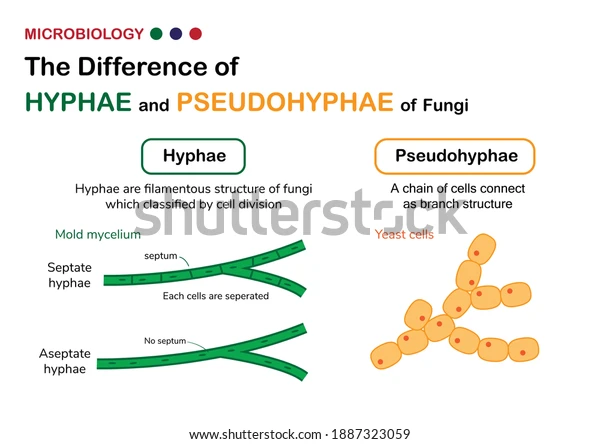1. Basic Forms
- Yeast
- Morphology: Unicellular, round/oval shape.
- Reproduction: Primarily by budding (asexual).
- Colonies: Appear smooth, mucoid, or creamy, similar to bacterial colonies.
- Examples: Candida albicans, Cryptococcus neoformans, Saccharomyces cerevisiae.
- Mold (Mycelium)
- Morphology: Multicellular, composed of filamentous structures called hyphae. A tangled mass of hyphae is called a mycelium.
- Reproduction: Via asexual or sexual spores.
- Colonies: Appear fuzzy, hairy, or woolly.
- Examples: Aspergillus, Rhizopus, Penicillium.
- Pseudohyphae
- Chains of elongated yeast cells that fail to detach after budding.
- Distinguished from true hyphae by constrictions at the septal sites.

- Classic Example: Candida albicans.
2. Hyphae Types (Molds)
- Septate Hyphae
- Hyphae are divided by cross-walls called septa.
- Septa have pores allowing communication between cells.
- Medically Important Examples: Aspergillus (acute angle branching), Dermatophytes.
- Aseptate (Coenocytic) Hyphae
- Lack septa, appearing as continuous, multinucleated tubes. This allows for rapid growth.
- Irregular, broad, ribbon-like appearance.
- Medically Important Examples: Mucorales order (e.g., Rhizopus, Mucor), which cause mucormycosis. These hyphae often show wide-angle, irregular branching.
3. Dimorphic Fungi
- Definition: Fungi that exist as either mold or yeast depending on the temperature. This is a key virulence factor.
- Pathophysiology: They are typically inhaled as mold spores from the environment and convert to the pathogenic yeast form in the warmer host tissues.
- Buzzword Mnemonic: “Mold in the Cold, Yeast in the Heat (Beast)”
- 25°C (environment): Mold form
- 37°C (in vivo/body temp): Yeast form
- High-Yield Pathogens:
- Histoplasma capsulatum: Yeast form is small, often seen within macrophages.
- Blastomyces dermatitidis: Yeast form is large with a single, broad-based bud.
- Coccidioides immitis: Forms a spherule (not a true yeast) containing endospores at 37°C.
- Paracoccidioides brasiliensis: Yeast form looks like a “captain’s wheel” (multiple buds).
- Sporothrix schenckii: Yeast form is cigar-shaped.
4. Asexual Spores (Conidia)
- Purpose: Primarily for reproduction and dispersal.
- Sporangiospores: Spores formed internally within a sac-like structure called a sporangium.
- Example: Rhizopus and Mucor.
- Conidia: Spores borne externally on a specialized structure called a conidiophore.
- Example: Aspergillus (forms a “fruiting body”), Penicillium.
Tip
- Canonical dimorphic fungi: yeasts (25 ℃) → mold (37 °C, = true hyphae)
- Candidiasis: pseudohaphae (25 ℃, formed by yeasts) → germ tubes (37 °C, = true hyphae)